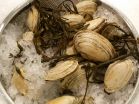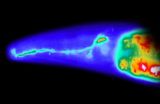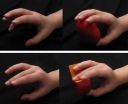(Press-News.org) Outbreaks of leukemia that have devastated some populations of soft-shell clams along the east coast of North America for decades can be explained by the spread of cancerous tumor cells from one clam to another. Researchers call the discovery, reported in the Cell Press journal Cell on April 9, 2015, "beyond surprising."
"The evidence indicates that the tumor cells themselves are contagious--that the cells can spread from one animal to another in the ocean," said Stephen Goff of the Howard Hughes Medical Institute and Columbia University. "We know this must be true because the genotypes of the tumor cells do not match those of the host animals that acquire the disease, but instead all derive from a single lineage of tumor cells."
In other words, the cancer that has killed so many clams all trace to one incidence of disease. The cancer originated in some unfortunate clam somewhere and has persisted ever since as those cancerous cells divide, break free, and make their way to other clams.
Only two other examples of transmissible cancer are known in the wild. These cancers include the canine transmissible venereal tumor, transmitted by sexual contact, and the Tasmanian devil facial tumor disease, transmitted through biting.
In early studies of the cancer in clams, Goff and his colleagues found that a particular sequence of DNA (which they named Steamer) was found at incredibly high levels in leukemic versus normal clam cells. While normal cells contain only two to five copies of Steamer, cancerous cells can have 150 copies. The researchers at first thought that this difference was the result of a genetic amplification process occurring within each individual clam.
But when first author of the study Michael Metzger analyzed the genomes of cancer cells collected in New York, Maine, and Prince Edward Island, he discovered something else entirely. The cancerous cells they'd collected from clams living at different locations were nearly identical to one another at the genetic level. They were clones.
"We were astonished to realize that the tumors did not arise from the cells of their diseased host animals, but rather from a rogue clonal cell line spreading over huge geographical distances," Goff said.
The result shows that the cells can survive in seawater long enough to reach and sicken a new host. It is not yet known whether the soft-shell tumor can spread to other molluscs, or whether there are mechanisms that recognize the malignant cells as foreign invaders and attack them.
Goff says there is plenty they don't know about this cancer, including when it first arose and how it spreads from one clam to another. They don't know what role Steamer played in the cancer's origin, if any. And they don't know how often these sorts of cancers might arise in molluscs or other marine animals.
But, the researchers say, the findings do suggest that transmissible cancers are more common than anyone suspected.
"Natural horizontal transmission of cancer between individuals has been considered a rare phenomenon, restricted to two exceptional cases in mammals," the researchers wrote. "Our finding of the horizontal transmission of a clonal clam leukemia extends the phenomenon to the marine environment, and demonstrates that this mechanism is more widespread in nature than previously supposed."
INFORMATION:
This work was supported by the Howard Hughes Medical Institute and the National Institutes of Health.
Cell, Metzger et al.: "Horizontal Transmission of Clonal Cancer Cells Causes Leukemia in Soft-Shell Clams"
Cell, the flagship journal of Cell Press, is a bimonthly journal that publishes findings of unusual significance in any area of experimental biology, including but not limited to cell biology, molecular biology, neuroscience, immunology, virology and microbiology, cancer, human genetics, systems biology, signaling, and disease mechanisms and therapeutics. For more information, please visit http://www.cell.com/cell. To receive media alerts for Cell or other Cell Press journals, contact press@cell.com.
Autism spectrum disorder (ASD) can produce strikingly different clinical outcomes in young children, with some having strong conversation abilities and others not talking at all. A study published by Cell Press April 9th in Neuron reveals the reason: At the very first signs of possible autism in infants and toddlers, neural activity in language-sensitive brain regions is already similar to normal in those ASD toddlers who eventually go on to develop good language ability but nearly absent in those who later have a poor language outcome.
"Why some toddlers with ASD get ...
Using induced pluripotent stem cells (iPSCs), a team led by Mount Sinai researchers has gained new insight into genetic changes that may turn a well known anti-cancer signaling gene into a driver of risk for bone cancers, where the survival rate has not improved in 40 years despite treatment advances.
The study results, published today in the journal Cell, revolve around iPSCs, which since their 2006 discovery have enabled researchers to coax mature (fully differentiated) bodily cells (e.g. skin cells) to become like embryonic stem cells. Such cells are pluripotent, able ...
LA JOLLA--If you had 10 chances to roll a die, would you rather be guaranteed to receive $5 for every roll ($50 total) or take the risk of winning $100 if you only roll a six?
Most animals, from roundworms to humans, prefer the more predictable situation when it comes to securing resources for survival, such as food. Now, Salk scientists have discovered the basis for how animals balance learning and risk-taking behavior to get to a more predictable environment. The research reveals new details on the function of two chemical signals critical to human behavior: dopamine--responsible ...
A genetic mutation associated with an increased risk of developing eating disorders in humans has now been found to cause several behavioral abnormalities in mice that are similar to those seen in people with anorexia nervosa. The findings, published online April 9 in Cell Reports, may point to novel treatments to reverse behavioral problems associated with disordered eating.
"It's been known for a long time that about 50% to 70% of the risk of getting an eating disorder was inherited, but the identity of the genes that mediate this risk is unknown," explains senior author ...
Two types of touch information -- the feel of an object and the position of an animal's limb -- have long been thought to flow into the brain via different channels and be integrated in sophisticated processing regions. Now, with help from a specially devised mechanical exoskeleton that positioned monkeys' hands in different postures, Johns Hopkins researchers have challenged that view. In a paper published in the April 22 issue of Neuron, they present evidence that the two types of information are integrated as soon as they reach the brain by sense-processing brain cells ...
It turns out sea turtles, even at a tender 6-18 months of age, are very active swimmers. They don't just passively drift in ocean currents as researchers once thought. NOAA and University of Central Florida researchers say it's an important new clue in the sea turtle "lost years" mystery. Where exactly turtles travel in their first years of life, before returning to coastal areas as adults to forage and reproduce, has puzzled scientists for decades.
"All species of sea turtles are endangered or threatened under the Endangered Species Act; knowing their distribution is ...
Building on their discovery of a gene linked to eating disorders in humans, a team of researchers at the University of Iowa has now shown that loss of the gene in mice leads to several behavioral abnormalities that resemble behaviors seen in people with anorexia nervosa.
The team, led by Michael Lutter, MD, PhD, assistant professor of psychiatry in the UI Carver College of Medicine, found that mice that lack the estrogen-related receptor alpha (ESRRA) gene are less motivated to seek out high-fat food when they are hungry and have abnormal social interactions. The effect ...
WASHINGTON -- Facial plastic surgery may do more than make you look youthful. It could change -- for the better -- how people perceive you. The first study of its kind to examine perception after plastic surgery finds that women who have certain procedures are perceived as having greater social skills and are more likeable, attractive and feminine.
The study is not superficial -- the importance of facial appearance is rooted in evolution and studies suggest that judging a person based on his or her appearance boils down to survival. The results were published online ...
Facial rejuvenation surgery may not only make you look younger, it may improve perceptions of you with regard to likeability, social skills, attractiveness and femininity, according to a report published online by JAMA Facial Plastic Surgery.
The relationship between facial features and personality traits has been studied in other science fields, but it is lacking in the surgical literature, according to the study background.
Michael J. Reilly, M.D., of the MedStar Georgetown University Hospital, Washington, and coauthors measured the changes in personality perception ...
Axillary lymph node evaluation is performed frequently in women with ductal carcinoma in situ breast cancer, despite recommendations generally against such an assessment procedure in women with localized cancer undergoing breast-conserving surgery, according to a study published online by JAMA Oncology.
While axillary lymph node evaluation is the standard of care in the surgical management of invasive breast cancer, a benefit has not been demonstrated in ductal carcinoma in situ (DCIS). For women with invasive breast cancer, sentinel lymph node biopsy (SLNB) replaced ...






